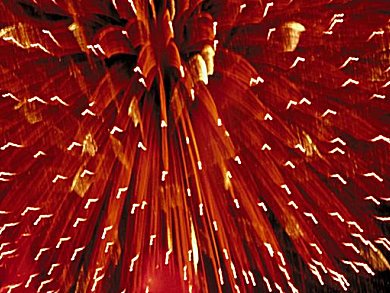Pyrotechnic applications like the annual fireworks on New Year’s Eve should become more environmental friendly, produce less soot and, if possible, no poisonous components.
Jörg Stierstorfer, University of Munich, Germany, developed a new firework from strontiumtetrazolate. Like other classical strontium salts it shines red while burning. With its particularly nitrogen-rich ring structure, the tetrazolate is similar to the composition of the outside air, which consists of 79 % nitrogen.
In addition, the researchers extended the strontiumtetrazolate with additional functional groups, so that their red flare produces a lot less smoke and fine dust than usual pyrotechnica. The new mixture does not require poisonous perchlorate salts, which are currently common oxidizing agents in flares.
Strontiumtetrazolate, however, is produced and used only where the budgets are large enough: According to Stierstorfer, the US Navy wants to start using it, for example, on aircraft carriers, where ground crews use burning signal torches to guide pilots during landing.
- This was a contribution of the German radio station Deutschlandfunk from their weekly radio show M3 – Mraseks Molecule Mosaik
Listen to the German radio show every Wednesday at 16:35 (find radio frequency) - Complete series on the internet (new shows are uploaded weekly)
- Interview with Tobias Stengel — Fine Arts & Chemistry
Tobias Stengler talkes about his interest in chemistry and the sciences and the connection between chemistry and fine art – he illustrates the weekly radio series
Go directly to the video and text provided by Deutschlandfunk (German)




